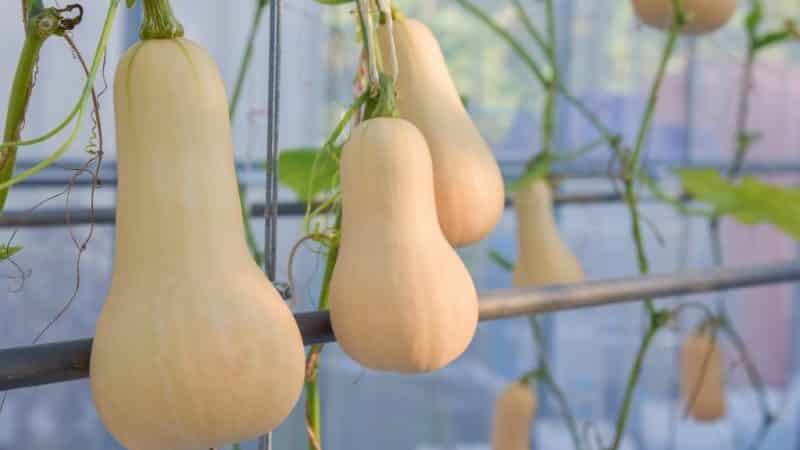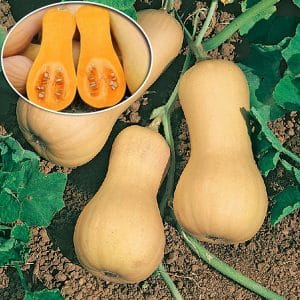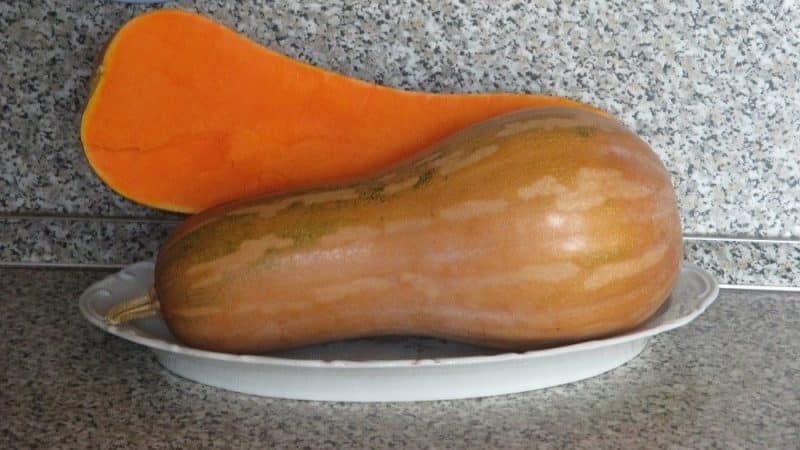We grow mid-season “Gitara” pumpkin with large fruits for long-term storage on our plot
Pumpkin is a useful melon crop. It is used in the preparation of soups, main courses and even desserts. The Guitar variety of butternut squash is popular among many gardeners. Excellent taste and long-term storage make it attractive to gardeners. In 2013, this nutmeg pumpkin variety was included in the State Register.
Description of the pumpkin variety
Spanish pumpkin is a medium-ripening variety. The harvest can be harvested in 110-120 days. Pumpkin is an annual plant with an extended root system that is capable of feeding large fruits. The taproot reaches a length of 240 cm.
Reference! The plant clings to the supports with the help of tendrils, which are located on the vine.
The pumpkin stem that spreads across the area has many soft hairs on the surface. It grows quickly and can reach 3-4.5 m. The leaves of the crop are five-lobed and located on long spiny stems. Color – dark green with whitish spots. The yellow-orange pumpkin flowers are large, about 10 cm in diameter.

Distinctive features
Guitar belongs to the muscat varieties, therefore it has a characteristic aroma of spices. Pumpkin tastes like carrots with an apricot aftertaste. The shape resembles a giant pear or guitar, that’s why it’s called that. The pulp contains plant fiber, vitamins and microelements.
Fruit characteristics
The fruits are large and elongated, 70-80 cm in length. Pumpkins reach a diameter of 12-15 cm at the narrowed part and 19-26 cm where the seeds are located. The thin and smooth peel covers the bright orange pulp, which occupies 90-95% of the fruit. One pumpkin can weigh from 2 to 6 kg.
The pumpkin pulp is dense and hard, and releases droplets when cut. juice. The vegetable is sweet, crispy, and easy to cut. It is eaten raw and cooked. During heat treatment, the taste reveals itself brighter and becomes more fragrant.
Reference! Taster rating: 4.9 points on a five-point taste scale.
Productivity
The variety is high-yielding, with excellent product shelf life up to 100 days. The average yield is 2.7-3.6 kg per 1 m² of crops. The heat-loving nature of the variety ensures maximum yield when grown in areas with a hot climate.
How to grow
Guitar variety pumpkin grow seedling method. However, in regions with a favorable climate, pumpkin can be grown by immediately planting the seeds in the ground.
Planting a plant
Pumpkin seeds begin to be planted in April. Before planting, they must be sorted out and disinfected. It is not necessary to process purchased seeds: information about the preventive measures taken can be read on the packaging.
Self-collected seeds from the previous harvest are treated with a solution of potassium permanganate and water. The seeds are then placed in a damp cloth for several days to allow them to sprout. Sprouted seeds are placed in small pots filled with peat.
Reference! To increase plant germination, planting material can be treated with wood ash. The ash is poured into hot water and the seeds are placed there for several hours.
After germination, the strongest sprout is selected, the weak ones are removed.Containers with seedlings are left on the south side, as the plant loves warmth and light. To prevent the soil from drying out under the rays of the sun, it is often moistened with water at room temperature.
After 3-4 weeks, the seedlings are planted in holes, abundantly watered. The plant is placed in rows; between the rows leave gaps of 1.3 m, and between the sprouts - at least 90 cm. After planting, the soil is compacted and, if necessary, covered with agrofibre.
Planting with seeds is carried out in the southern regions. Disinfected and germinated seeds are immersed in holes to a depth of 5-10 cm. 2-3 seeds are placed in one hole at once. Plants are watered and covered if necessary. After the sprouts appear, they are thinned out, leaving the strongest ones.
Plant care
This pumpkin variety is easy to care for. However, dense foliage needs thinning. And after 2-3 ovaries form on the stems, the pumpkin is pinched so that the plant is not overloaded and receives full nutrition. Side shoots are also cut off so that the fruits have time to ripen.
16-22 days after planting seedlings carry out fertilizing. The second time fertilizer is applied during the period when the ovaries are formed.
Reference! Organic fertilizers include bird droppings, mullein, herbal infusions or a comprehensive set of vegetable fertilizers. Wood ash is sprinkled around the root of the pumpkin.
Watering pumpkins is exclusively soil-based. Water should not get on the leaves, as this can lead to the formation of fungal diseases. When grown in greenhouses, pumpkin is watered 2 times a week with warm, settled water. Outdoors the plant has enough natural precipitation. After watering, the soil must be loosened to ensure an influx of oxygen and kill weeds.
Features of cultivation and possible difficulties

The culture loves warmth and sunlight. Therefore, when planting sprouts in open ground, the weather should be warm, without the risk of recurrence of frost. When transplanted into the ground, the plant must have at least 3 grown leaves.
When looking for containers for pre-seeding, you need to choose spacious and deep containers so that the pumpkin root system does not experience discomfort. When transplanting, take the earthen ball carefully, since the pumpkin root is very delicate. Even with minimal destruction of the coma, the plant may die.
Growing tips from experienced gardeners
Experienced gardeners advise planting pumpkins on light, fertile sandy loam soils with the addition of humus. It is better to use a greenhouse made of polycarbonate, which allows sunlight to pass through. Moderate watering and ventilation are recommended.
In open soils they are planted when the soil temperature reaches +12°C. The soil is fertilized every fall so that when plants are planted in the spring, the soil is filled with the necessary nutrients.
Diseases and pests
With heavy summer rains and sudden changes in night and day temperatures, the plant is at risk of developing root rot and bacteriosis. For prevention, overgrown lashes are thinned out. If the plant is sick, it is necessary to remove the diseased parts, and after harvesting, collect and destroy the remains of the plants.
From time to time, a pumpkin can be attacked by spider mites or melon aphids. Insects are controlled by spraying insecticides and acaricides.
Reference! To prevent the appearance of mites, plants are irrigated with an infusion of onion or garlic peels.
Harvesting and application

The harvest is harvested in early autumn.The fruits are removed along with the stems, which protects the delicate peel from damage. The pumpkin is placed in a basement or other dark room until fully ripe. The longer a vegetable is stored, the better its taste becomes. During the ripening period, the surface of the pumpkin hardens, and the flesh becomes a rich orange color.
Reference! If maintained at a low level of humidity, the fruits can be stored for 3-4 months.
The vegetable contains many vitamins, is used during a diet, and removes harmful, toxic substances from the body. Pumpkin does not contain cholesterol and is used as a diuretic. Eating vegetables strengthens the immune system and cardiovascular system.
Advantages and disadvantages of the variety
Butternut squash has many benefits:
- sweet, juicy pulp;
- large fruits with excellent presentation;
- opportunity long-term storage;
- resistance to arid climates;
- stable immunity to diseases subject to the rules of cultivation.
The variety has virtually no disadvantages. However, when growing, keep in mind that the plant is not suitable for growing in open ground in the northern regions.
Other varieties of butternut squash
There are several varieties that are classified as butternut squash.
Pearl
The harvest ripens in 115-125 days. Small dark green leaves have light spots on the surface. The elongated shape of the fruit resembles a nesting doll. The peel is bright orange, smooth to the touch. The weight of the fruit is 4 kg with a length of 50 cm.
The dark orange flesh is juicy and sweet in taste. The value of the variety lies in its high carotene content. Pumpkin is used in cooking to prepare a variety of dishes.
Vitamin
Pumpkin late ripening, the harvest appears on the 125-130th day.From 1 m² you can harvest 4 kg of pumpkin. The plant has pentagonal green leaves, on which small gray spots can be seen.
The fruits have an oval shape and a segmented surface. The fruits reach a weight of 7 kg. The skin is brown-brown in color with a visible green mesh. The bright orange flesh is thick and sweet in taste.
Farmer reviews

Gardeners who have ever grown the Guitar variety claim that even with minimal expenditure of money and effort, it is not difficult to get an excellent harvest.
Svetlana, Kostroma: “The pumpkin grows in a slightly different shape, not the same as in the photo. I keep pumpkins fresh for quite a long time in the cellar at home, in winter I cook porridge with pumpkin - it tastes like honey, the children eat it with pleasure.”
Irina, Uglich: “Pumpkin Guitar does not require watering, sometimes I don’t go to the garden for a week, it feels great. We don’t eat pumpkin ourselves, but the sweet pulp makes an excellent vitamin supplement for our grandchildren.”
Conclusion
A bright representative of the muscat varieties, Guitar has no shortcomings in taste and is unpretentious in care. A large amount of sunlight and maintaining temperature and humidity conditions will provide gardeners with a bountiful harvest and a supply of vitamins throughout the winter.